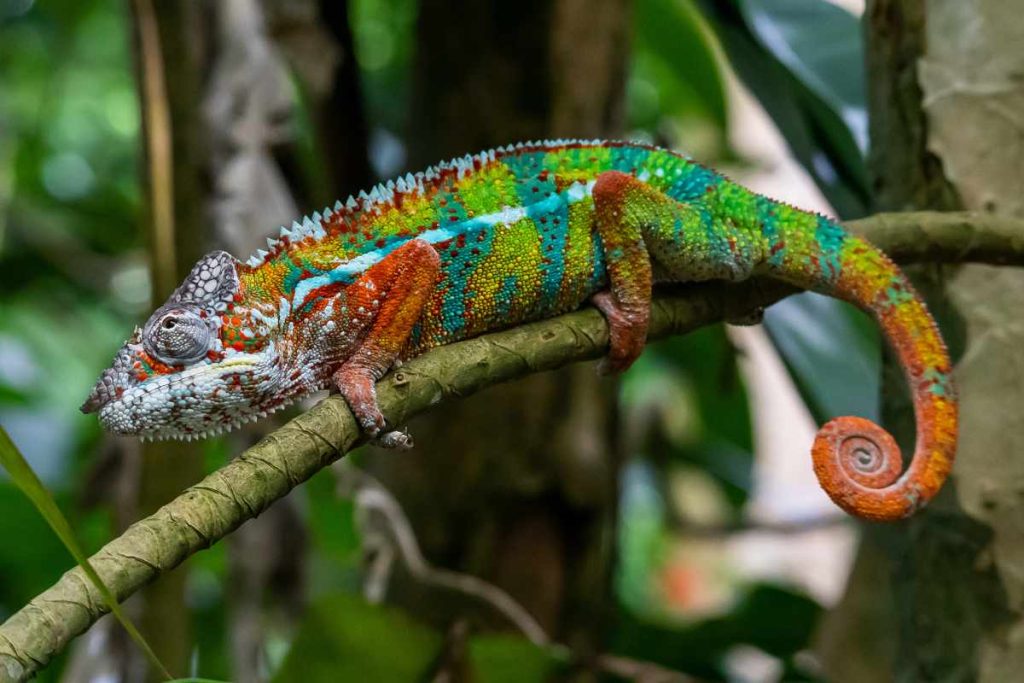Panther Chameleons - Color Changes and Environment

Discover why panther chameleons change color, how their environment and health affect them, and expert care tips to keep your pet chameleon vibrant and healthy.
Panther chameleons are among the most vibrant and captivating reptiles in the world.
Famous for their eye-catching color transformations and intricate patterns, these reptiles fascinate both pet owners and researchers.
While their stunning color shifts are well-known, these changes are closely linked to environmental factors and emotional state.
Understanding these triggers and providing the proper care is essential for any responsible chameleon owner.
Get to Know the Panther Chameleon
Panther chameleons (Furcifer pardalis) originate from Madagascar, primarily in the northern and eastern regions.
Their vivid color spectrum ranges from bold reds, oranges, and blues to softer greens and yellows.
These reptiles are highly sought after as pets due to their manageable care requirements and spectacular appearance.
Physical Characteristics:
Size: Males can reach up to 18 inches in length, while females typically measure around 12 inches.
Coloration: Males display bold, vibrant patterns; females tend to have softer tones.
Lifespan: In captivity, panther chameleons typically live up to 5 years, depending on their care and habitat conditions.
The Science Behind Color Changes
Color change in panther chameleons serves multiple functions beyond aesthetics, including communication, camouflage, and temperature regulation.
Communication and Social Signaling
Panther chameleons use their color changes primarily to communicate with other chameleons.
Males often display bright, bold colors to assert dominance or attract a mate, signaling their presence and fitness to rivals and potential partners.
In contrast, softer, subdued colors indicate calmness or peaceful intent, helping reduce tension during social interactions.
When threatened, chameleons may exhibit aggressive displays, with intense color shifts serving as a warning to rival males or intruders.
Camouflage and Predator Avoidance
Color change also plays a critical role in camouflage and protection from predators.
Panther chameleons adjust their skin tones to match their surroundings, adopting shades of green, brown, or gray to blend into foliage or shaded areas.
Additionally, they can modify their colors based on the lighting conditions, ensuring they either remain hidden or stand out as needed for communication or safety.
Thermoregulation
Another essential function of color change is thermoregulation.
When a chameleon needs to absorb more heat, its skin darkens to increase heat absorption, while lighter tones help reflect sunlight and prevent overheating.
This dynamic adaptation allows panther chameleons to maintain optimal body temperature throughout the day.
Environmental and Habitat Considerations
Temperature and Lighting
The environment is one of the most important factors influencing color changes in panther chameleons.
Proper UVB exposure is essential for calcium absorption and overall health, which in turn affects their vibrancy. Providing both a warm basking area (85–95°F) and a cooler zone (70–80°F) allows chameleons to regulate their body temperature naturally.
Additionally, maintaining a consistent day-night cycle helps support their diurnal rhythms and subtle color shifts as daylight fades.
Tip: Use UVB light for 10–12 hours daily, combined with a basking spot and cooler zone for thermoregulation.
Social Interactions and Behavioral Signals
Panther chameleons use color to communicate. During territorial disputes, males display brighter colors to deter rivals, while during courtship, the intensity and vibrancy of their hues signal health and genetic fitness.
Tip: Understanding these behavioral cues helps owners interpret their chameleon’s mood and stress levels.
Stress, Fear, and Environmental Triggers
Chameleons are sensitive reptiles. Stressors such as new environments, excessive handling, or loud noises can cause them to exhibit darker, muted tones, indicating anxiety or discomfort.
Observing these changes can help prevent health problems and ensure the chameleon’s emotional well-being.
Tip: Keep humidity around 60–80% with misting systems or trays, while ensuring good ventilation to prevent respiratory issues.
Diet and Health
A balanced diet directly impacts coloration. Feeding a mix of live insects, vegetables, fruits, and supplements maintains vivid and healthy colors.
Conversely, poor nutrition or illness can lead to dull, faded hues, serving as a warning sign that attention or veterinary care may be needed.
Tip: Offer a varied diet with calcium and vitamin supplements, and provide hydration through misting or dripping water systems.

Common Problems and Precautions
Stress signs: Dark or muted colors, decreased appetite, hiding.
Health risks: Poor diet, dehydration, and improper lighting.
Aggression: Keep multiple males separate to prevent conflicts.
Temperature extremes: Avoid overheating or chilling to maintain vibrant coloration.

Nurturing Your Panther Chameleon’s Beauty
The color changes of panther chameleons reflect their mood, health, and environment.
Understanding these factors and providing proper care ensures your chameleon remains vibrant and thrives.
Take Action: Observe your chameleon’s color shifts, optimize its habitat, and provide a balanced diet to support a healthy, colorful life.
A well-cared-for chameleon not only displays dazzling colors but also enjoys a longer, healthier life.
Did you find this post useful or inspiring? Save THIS PIN to your PETS Board on Pinterest!






You may also like